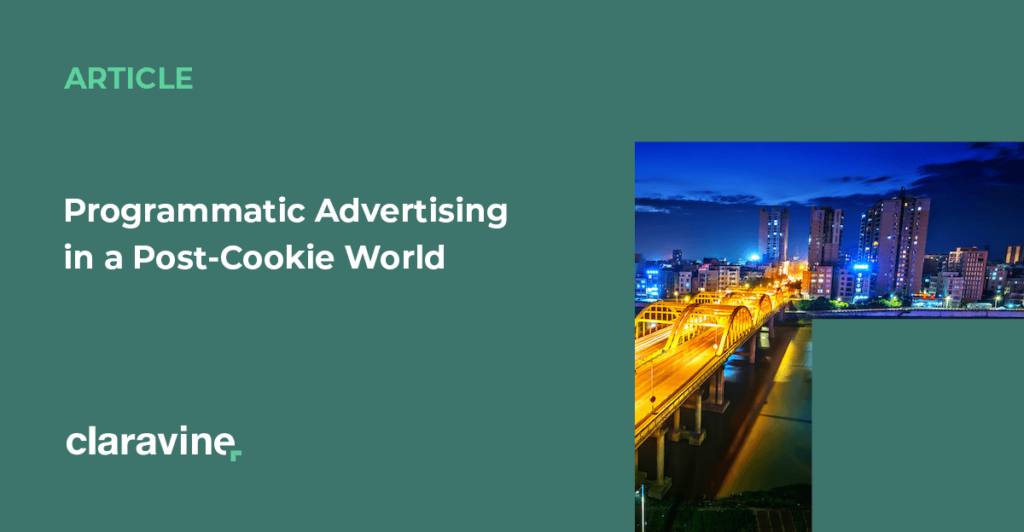The Future of Programmatic Advertising in a Post-Cookie World

The digital advertising industry has had to adapt to worldwide consumer demand for stricter privacy controls. Regulations set forth by GDPR and CCPA, Apple’s changes to IDFA, and Google’s upcoming phase-out of third-party cookies are forcing advertisers to find new ways to reach consumers.
Brands that rely on programmatic advertising and don’t have strong first-party data sets to target effectively are most impacted by these changes. For industries like CPG, manufacturing, wholesale and others, developing new strategies is especially critical.
Of course, programmatic ads aren’t going anywhere —they’re expected to account for 89% of all digital display ad spending in 2021.
But it will look a little different in the future. Here are some adjustments the industry has started to make.
But let’s start with a definition first.
Table of Contents
What is Programmatic Advertising and Why It’s Important
Programmatic advertising is defined as the fully automated data-driven method of media buying and selling ad space on publishers’ websites. Through complex algorithms and machine learning, brands have the ability to show the right ad to the right customer in real time.
Programmatic advertising transformed the way brands buy and sell ad space. It replaced the traditional, manual process involving RFPs, negotiations, contracts, time, and financial resources. And it made it possible to measure the ROI of ad campaigns in real time.
Programmatic Advertising: 6 Shifts to Accommodate the Private Web
Google’s recent announcement delaying the deprecation of third-party cookies until the end of 2023 gives advertisers more time to test new strategies.
But brands are already leveraging effective alternatives for tracking and targeting consumers in a post-regulation world.
Here’s what we’ll continue to see in the programmatic advertising space.
1. Renewed Focus on Contextual Targeting
We can expect a resurgence of contextual targeting — matching ads to a website’s content — as advertisers’ primary targeting method.
Improvements in artificial intelligence (AI) have made it possible to better understand the meaning of content within a website while sophisticated algorithms display ads when users are engaged with the topic or keyword. Together they ensure brand safety by placing ads in the appropriate environments without using personal or third-party data.
2. Leveraging of Private Marketplaces
We’ll see more brands shift resources away from open ad exchange to the private marketplace (PMP), exchanges run by individual publishers.
PMPs leverage first-party data amassed by publishers through what are often extensive web portfolios. Advertisers can drill into consumers’ demographics and interests to place their ads for maximum relevance and impact. Along with access to first-party data, PMPs provide more transparency and control, giving advertisers confidence they’re displaying ads alongside brand-safe content.
3. Investment in Advertising Creative
Impactful and engaging creative is a key pillar of effective advertising. But it’s arguably taken a backseat to technological innovations in digital marketing. It made sense — using platforms that leverage third-party data for ad targeting was advantageous from a resources standpoint.
That quantity over quality approach explains why the majority of digital ads are annoying — and not remotely engaging. With a renewed focus on the creative aspect of advertising, we’ll see more brands investing in cross-channel storytelling that drives engagement instead of product-focused display ads that follow consumers around the web. Companies will be forced to establish real, lasting relationships with their customers that are based on value and content. Traditional measurement KPIs like CPA, ROAS, CPC and CPM will now require true enrichment and context to be understood. Some of these metrics will be completely replaced by more qualitative, engagement driven metrics.
4. Improved Targeting Through Ad Experimentation and Testing
Most businesses with a website or an app test different layouts, colors, landing pages, and checkout processes to ensure optimal brand representation and the best possible user experience.
However, they’ve been less inclined to experiment with advertising campaigns even though optimizing ad spend is consistently a top priority. Yet, pretesting can improve an ad’s effectiveness by at least 20%. Add the absence of the third-party cookie, making walled gardens even more walled, it becomes a significant challenge to track and test across channels as we once could do.
Right now, brands are able to throw variations of campaigns and content out into the world to observe which strategies worked. Soon (or now if you’re reading this in the near future), brands won’t have that luxury.
Smart brands are shifting to an experimentation model, isolating a particular known audience within a walled garden or platform, testing content and tactics, and then repeating the successful ones at scale across other walled gardens. Informed inferences, associations, models and assumptions will be critical to brands marketing success, more so than ever before. We can expect brands to incorporate more testing to improve targeting to reap the benefits of programmatic advertising.
5. Shift to In-House Programmatic
Certain brands will bring programmatic advertising in house, where they’ll have greater control over cost, data, and intellectual property. Of course, they’ll need vast stores of first-party data or information collected through direct interactions with consumers.
But bringing it in-house is no small feat. A complete solution requires a centralized data management platform (DMP), change management, in-house expertise, and a connected AdTech platform. For some brands it’s worth the effort and cost to retain control of consumer data, improve transparency, and minimize ad fraud.
Similar benefits can be achieved through a hybrid programmatic advertising model where there’s some reliance on partners or agency expertise.
6. Continued Growth of Other Programmatic Formats
Of course programmatic advertising isn’t restricted to the internet. We can expect advertisers to devote more resources to other formats as they move away from tactics that rely on third-party data.
Mobile Geotargeting
Mobile geotargeting taps into the GPS information on mobile devices enabling brands to pinpoint specific consumers when they’re on the move — so long as they’ve enabled location tracking — with the right ad at precisely the right time. Potential applications include ad impressions for drink specials at a nearby coffee chain during the morning commute and BOGO entree at a local restaurant just before the lunch hour.
Audio
With programmatic audio advertisers target consumers when they’re not on their screens and listening to digital audio instead — 1 hour and 29 minutes per day for the average adult. Since consumers log in to listen to digital radio, music-streaming services, podcasts, etc., advertisers are able to target effectively according to data points like age, gender, device, and listening habits. Considering these consumers are also particularly captive (many listen through headphones), audio seems like a sound investment.
Out-of-Home (OOH)
Advertising on billboards and signage is nothing new, but with dynamic digital display and targeting capabilities, they become a compelling and effective way to advertise. Electronic billboards on buses and buildings, inside airport terminals, stadiums — out-of-home (OOH) is one form of programmatic advertising that is hard to ignore, unless of course, you close your eyes.
Over-the-Top (OTT)
OTT advertising bypasses TV providers and delivers ads through streaming video services and connected TVs (CTV). Advertisers are able to present relevant ads in real-time, targeted to their ideal consumer based on demographics, context, time of day, location, and the content being consumed. And as you’ve probably noticed, they’re non-skippable on most devices and platforms — an attractive feature for advertisers.
The Future of Programmatic Advertising Remains Bright
Brands will continue to depend on programmatic advertising to get in front of their target customers, and they’ll devote a significant amount of their ad spend to do so. But they’ll explore different formats that promote creativity and new ways to reach consumers while honoring privacy.
It’s worth mentioning that ads are as good — or as bad — as the data behind them.
Evaluating your programmatic buying and advertising strategy involves revisiting your business’ overall data strategy too. Claravine can help establish relationships and patterns across already existing first-party data, creating data integrity and context that is critical to the new experimentation programmatic world.



